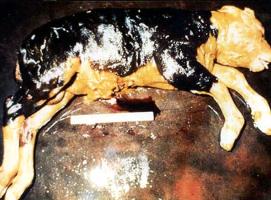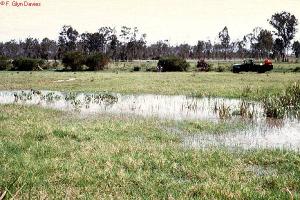Rift Valley Fever
Scientific Names: Enzootic hepatitis
Description: Mosquito borne disease
Host: domestic ruminants (cattle, sheep, goats, camels, domestic buffaloes) and human
Introduction
Rift Valley Fever (RVF) is an acute mosquito-borne viral disease affecting domestic ruminants (cattle, sheep, goats, camels, domestic buffaloes) and man. It occurs mainly in Eastern and Southern Africa. Outbreaks have also occurred in Egypt, West-Africa (Mauretania), (in 2000 in Saudi Arabia and Yemen. During epidemics the sudden occurrence of mass abortions at all stages of pregnancy especially in sheep and camels, deaths in new-born animals and severe influenza like occasionally also fatal haemorrhagic disease in humans are characteristic.
Apart from Rabies, RVF is probably the most deadly zoonotic disease transmitted from animal to man. RVF outbreaks in Eastern Africa, including Somalia, have caused hundreds of deaths in humans.
Formerly, apart from mass abortions, most cases in adult animals were mild, but in recent times a haemorrhagic form of the disease has emerged with rapid death in mature animals, including even cattle.
There is a remarkable age-related innate resistance to RVF virus; mortality rate in lambs less than 1 week old exceeds 90% whereas the rate in lambs over 1 week drops to 20%.
 |
| Aborted foetus after Rift Valley Fever |
|
© USDA
|
 |
| Widespread flooding causing mosquito eggs to hatch |
|
© F. Glyn Davies
|
Major RVF outbreaks in animals and humans occur in 5 to 20 year cycles. Between epidemics, the virus survives in mosquito eggs laid on vegetation at the edge of flood zones When these are flooded the eggs hatch. This only occurs when the water table rises following prolonged and very heavy rain, for example during El-Nino. The mosquitoes hatch in massive numbers and start infecting livestock.
Mode of spread
Epidemics in domesticated animals are started by the bites of infected mosquitoes. After this, infective droplets generated by aborted foetuses and abortion fluids spread the disease rapidly through the flock or herd.
Humans are usually infected by inhaling infectious droplets when handling infected animals or tissues (meat!) or abortion materials. This occurs when slaughtering animals during a RVF outbreak and when assisting infected animals during abortion. Until recently the disease in man was considered to be a non-serious influenza type illness, but a fatal haemorrhagic form has emerged and now RVF in human is considered to be one of the most dangerous diseases known.
The virus may spread over large areas by windborne mosquitoes and also through movement of infected animals.
Signs of Rift Valley Fever
- The incubation period in lambs is 12 to 36 hours. A fever of up to 41°C (106°F) may develop.
- Peracute infections occur in new-born lambs which die within hours. Acute reactions occur in older lambs and calves and occasionally in adult sheep.
- In very severe infection in calves, death may occur in 2 days after infection without their showing any clinical signs.
- A haemorrhagic syndrome was observed during the last outbreak in Kenya, affecting adult cattle.
- In its severe form, calves will develop high fever, and may vomit. Some nasal discharge may also be seen followed by prostration and mortality may reach up to 70%.
- Almost all infected pregnant sheep and camels abort within a short period and at very different stages of pregnancy. Cattle are more resistant but may also abort.
- Subacute reactions occur in adult sheep, cattle and camels. There is a low-grade fever, partial lack of appetite and general weakness. Jaundice is prominent and foul smelling diarrhoea can occur.
- In pregnant ewes the mortality and abortion rates varies from 5 - 100%. Abortion rates in pregnant camels are between 80% and 100%
Diagnosis
When suspecting RVF do not touch abortion materials, keep a distance from aborting animals, do not attempt any post-mortems and stop all slaughter of animals for meat. Blood tests are used to confirm a RVF diagnosis. The DVO or vet department should immediately be alerted when unusually high numbers of abortions occur soon after strong rainfall and flooding.
In sick humans, there is a lack of appetite, nausea, severe headache, joint pains, dizziness and nose bleeding. Encephalitis, retinitis, photophobia, loss of central vision, irritation, stupor and coma can occur. Haemorrhagic RVF is characterised by a very acute febrile illness, accompanied by jaundice. Widespread haemorrhages develop within 2-4 days and death usually occurs within another 3-6 days. There is no treatment for RVF in livestock and humans. Patients who are immune-suppressed or malnourished are at particular risk of death.
Recovery from RVF is followed by lifelong immunity.
Prevention and Control
- Outbreaks of Rift Valley Fever generally occur after periods of prolonged and very heavy rain. Such being the case livestock owners should be aware that if long rains are excessively heavy and cause widespread flooding, an outbreak of Rift Valley Fever is likely to occur.
- Control of mosquitoes through use of insecticides, acaricides and pour-ons, movement of stock to dry areas or to higher cooler altitudes can all help in preventing the RVF outbreak from reaching your herd.
- Immunisation remains the only effective way to protect livestock but vaccination of animals with suitable RVF vaccines can only be carried out under authority of the DVS by government veterinary vaccination teams. Some live RVF vaccines can also cause abortions and should NOT be used in pregnant animals.
Treatment
There is no known medical treatment for Rift Valley Fever.
